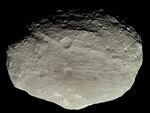Astronomy:(471240) 2011 BT15
| Discovery[1][2][3] | |
|---|---|
| Discovered by | Pan-STARRS |
| Discovery site | Haleakala Obs. |
| Discovery date | 24 January 2011 |
| Designations | |
| (471240) 2011 BT15 | |
| 2011 BT15 | |
| Minor planet category | NEO · PHA · Apollo[1][2] |
| Orbital characteristics[1] | |
| Epoch 4 September 2017 (JD 2458000.5) | |
| Uncertainty parameter 0 | |
| Observation arc | 9.63 yr (3,519 days) |
| |{{{apsis}}}|helion}} | 1.6842 AU |
| |{{{apsis}}}|helion}} | 0.9018 AU |
| 1.2930 AU | |
| Eccentricity | 0.3025 |
| Orbital period | 1.47 yr (537 days) |
| Mean anomaly | 204.24° |
| Mean motion | 0° 40m 13.08s / day |
| Inclination | 1.6613° |
| Longitude of ascending node | 105.37° |
| 308.78° | |
| Earth MOID | 0.0008 AU · 0.3 LD |
| Physical characteristics | |
| Mean diameter | 0.136 km (calculated)[4] 0.150 km[5] |
| Mass | 4.9×109 kg (assumed)[5] |
| Rotation period | 0.109138±0.000002 h[6] |
| Geometric albedo | 0.20 (assumed)[4] |
| S[4] | |
| Absolute magnitude (H) | 21.7[1][4] |
(471240) 2011 BT15, provisional designation 2011 BT15, is a stony, sub-kilometer sized asteroid and fast rotator, classified as a near-Earth object and potentially hazardous asteroid of the Apollo group.[1] It had been one of the objects with the highest impact threat on the Palermo Technical Impact Hazard Scale.[7]
Discovery
It was discovered on 24 January 2011, by a team of astronomers at Pan-STARRS, the Panoramic Survey Telescope and Rapid Response System at Haleakala Observatory on Hawaii, United States. The discovery was made using a 1.8-meter Ritchey–Chrétien telescope. At the time of discovery, the object had an apparent magnitude of 22.[2][3]
Orbit
Before the 2013 recovery it had an observation arc of 41 days with an uncertainty parameter of 7. Due to precovery images from 2007 it now has an observation arc of more than 5 years.[1] It makes close approaches to Earth and Mars.[8]
On 28 December 2013, it passed 0.03222 AU (4,820,000 km) from Earth.[8] The December 2013 passage was studied by the Goldstone Deep Space Network and further refined the orbit.[9]
Impact risk
While listed on the Sentry Risk Table, virtual clones of the asteroid that fit the uncertainty region in the known trajectory showed a 1 in 71,000 chance that the asteroid could impact Earth on 5 January 2080.[5]
In 2013 it had the 5th highest impact threat on the Palermo Technical Impact Hazard Scale.[7] It was removed from the Sentry Risk Table on 17 June 2013.[10]
With a 2080 Palermo Technical Scale of −3.58,[5] the odds of impact by 2011 BT15 in 2080 were about 3800 times less[11] than the background hazard level of Earth impacts which is defined as the average risk posed by objects of the same size or larger over the years until the date of the potential impact.[12] JPL Horizons shows that the nominal pass will be on 17 January 2080 at a distance of 0.125 astronomical unit|AU (18,700,000 km; 11,600,000 mi) from Earth.[13]
Physical characteristics
This near-Earth object is characterized as a common, stony S-type asteroid by the Collaborative Asteroid Lightcurve Link (CALL).[4]
Fast rotator
In January 2014, a rotational lightcurve of 2011 BT15 was obtained from photometric observations by American astronomer Brian Warner at the CS3-Palmer Divide Station (U82) in California. Lightcurve analysis gave a well-defined rotation period of 0.109138 hours (393 seconds) with a brightness amplitude of 0.61 magnitude ({{{1}}}).[6]
Diameter and albedo
According to the CALL and JPL's impact-risk table, this near-Earth object measures 136 and 150 meters, respectively.[4][5] For its size estimate, CALL uses a standard for stony asteroids of 0.20 with an absolute magnitude of 21.7.[4]
Naming
As of 2017, this minor planet remains unnamed.[2]
References
- ↑ 1.0 1.1 1.2 1.3 1.4 1.5 "JPL Small-Body Database Browser: 471240 (2011 BT15)". Jet Propulsion Laboratory. https://ssd.jpl.nasa.gov/sbdb.cgi?sstr=2471240. Retrieved 2 June 2017.
- ↑ 2.0 2.1 2.2 2.3 "471240 (2011 BT15)". Minor Planet Center. https://www.minorplanetcenter.net/db_search/show_object?object_id=471240. Retrieved 24 April 2017.
- ↑ 3.0 3.1 "MPEC 2011-B43 : 2011 BT15". IAU Minor Planet Center. 2011-01-27. https://minorplanetcenter.net/mpec/K11/K11B43.html. Retrieved 2013-01-10. (K11B15T)
- ↑ 4.0 4.1 4.2 4.3 4.4 4.5 4.6 "LCDB Data for (471240)". Asteroid Lightcurve Database (LCDB). http://www.minorplanet.info/PHP/generateOneAsteroidInfo.php?AstInfo=471240%7C. Retrieved 24 April 2017.
- ↑ 5.0 5.1 5.2 5.3 5.4 "Earth Impact Risk Summary: 2011 BT15". Wayback Machine: NASA/JPL Near-Earth Object Program Office. Archived from the original on February 18, 2013. https://web.archive.org/web/20130218175502/http://neo.jpl.nasa.gov/risk/2011bt15.html. Retrieved 2013-07-27. (1.4e-05 = 1 in 71,000 chance)
- ↑ 6.0 6.1 Warner, Brian D. (July 2014). "Near-Earth Asteroid Lightcurve Analysis at CS3-Palmer Divide Station: 2014 January-March". The Minor Planet Bulletin 41 (3): 157–168. ISSN 1052-8091. PMID 32549046. Bibcode: 2014MPBu...41..157W.
- ↑ 7.0 7.1 "Sentry Risk Table". Wayback Machine: NASA/JPL Near-Earth Object Program Office. 10 Jan 2013. Archived from the original on January 10, 2013. https://web.archive.org/web/20130110053551/http://neo.jpl.nasa.gov/risk/. Retrieved 2013-07-27.
- ↑ 8.0 8.1 "JPL Close-Approach Data: (2011 BT15)". https://ssd.jpl.nasa.gov/sbdb.cgi?sstr=2011BT15;cad=1#cad. Retrieved 2013-01-10.
- ↑ Dr. Lance A. M. Benner (2013-08-12). "Goldstone Asteroid Schedule". NASA/JPL Asteroid Radar Research. http://echo.jpl.nasa.gov/asteroids/goldstone_asteroid_schedule.html. Retrieved 2013-08-16.
- ↑ "Date/Time Removed". NASA/JPL Near-Earth Object Program Office. http://neo.jpl.nasa.gov/risk/removed.html. Retrieved 2013-07-27.
- ↑ Math: 103.58 = 3801
- ↑ "The Palermo Technical Impact Hazard Scale". NASA/JPL Near-Earth Object Program Office. 31 Aug 2005. http://neo.jpl.nasa.gov/risk/doc/palermo.html. Retrieved 2011-10-14.
- ↑ Horizons output. "Horizon Online Ephemeris System". http://ssd.jpl.nasa.gov/horizons.cgi?find_body=1&body_group=sb&sstr=2011BT15. Retrieved 2013-01-10. (Geocentric Solution)
External links
- Asteroid Lightcurve Database (LCDB), query form (info )
- Dictionary of Minor Planet Names, Google books
- Asteroids and comets rotation curves, CdR – Observatoire de Genève, Raoul Behrend
- (471240) 2011 BT15 at NeoDyS-2, Near Earth Objects—Dynamic Site
- Ephemeris · Obs prediction · Orbital info · MOID · Proper elements · Obs info · Close · Physical info · NEOCC
- (471240) 2011 BT15 at ESA–space situational awareness
- (471240) 2011 BT15 at the JPL Small-Body Database
 |







